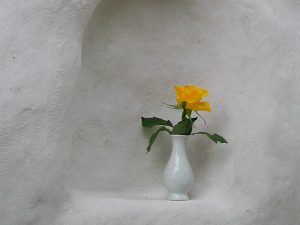You may be interested in following the process through from beginning to end – although you may not want to burn your own limestone, you may want to slake quicklime. If you are able to do it, you will save money, but it can be dangerous, and you may not be too popular with the neighbours, as it gives off lots of fumes.
It’s difficult for the public to buy quicklime, as it’s dangerous.
See ‘health and safety’ above if you are thinking of slaking your own lime. Quicklime is more dangerous than putty, as it is in powder form which can blow around, and putty is mostly water, which dilutes and turns the thirsty quicklime to calcium hydroxide. Mortar and plaster is less hazardous still, but we still advise using goggles as it can burn if it gets into your eye.
Do it in a very well-ventilated place, preferably outdoors.
If you do buy quicklime, it’s probably better to ask for powder and not small lumps. We have found small unburnt limestone pebbles in the middle of lumps when we’ve come to slake them, and have had to pick them out of mortars and plasters later.
Don’t store quicklime – slake and store lime putty. Lime putty gets better with age, but quicklime could begin to slake itself from moisture in the air (and then it could actually start to take CO2 from the air and start to become calcium carbonate again!), and become useless.
In a large metal container (an old bath is ideal – nothing plastic though, as the heat generated by the reaction will melt it) add one part quicklime to three parts water. Make sure the bath is stable (by wedging it with bricks etc.) and of course that the plug is in or the hole filled.
Always add quicklime to water, and NEVER water to quicklime, as it will spit, and can be very dangerous.
There will be a violent chemical reaction with heat given off. You can test a small amount in a metal bucket first. If the reaction is sluggish, you can use hot water, although we’ve never found any quicklime to react sluggishly – quite the opposite in fact.
Temperatures over 100°C are achieved – water boils, lots of steam given off – and there will be some quicklime in the steam, so best not breathe it. Wear a face mask.
If the reaction is sluggish, or the mix is too wet, it probably needs more quicklime
Rake continuously until all lumps are removed. Rake backwards and forwards with an old rake. When the bubbling stops and there are no more lumps, cover with an old board with bricks on top, and go back to it to rake it again after an hour, and then again an hour after that.
Then cool, shovel the putty into plastic buckets (with lids to stop surface water evaporating). Lime putty generates water that rises to the top when it cools. Make sure this layer of water is retained in the bucket before you put the lid on. If there is no film of water, add some.
Leave the putty for at least 3 months – it will generate its own limewater on the surface. Putty must not be exposed to air. The longer you leave the putty, the better it will be, and it will ensure that absoultely all the quicklime is slaked. Store in a frost-free place. Lime putty will store forever, as long as there is a layer of water at the top, with a lid.
If you have the facilities to slake your own, it will be cheaper, because putty is mostly water.

Slaking lime in an old bath
Cost implications
You can buy quicklime and slake it yourself; you can buy lime putty (ie quicklime that has been slaked); or you can buy lime mortar. They all cost around the same. However, as lime putty is slightly more than 2/3 water, if you slake your own, your lime putty will then cost you around 1/3 the price. So, if you slake your own quicklime, your lime putty will work out cheaper than cement.
Lime mortar is 4/5 sand, so if you slake your own lime and mix your own mortar it will work out around a quarter the price of bought mortar, and even if you buy putty, then mix your own mortar, it will cost less than half the price.
So as you can see, the more of the process you do yourself, the cheaper your mortar (or plaster) will be. But that’s if you don’t account for your time to do it. If you like getting your hands dirty, and trying different things, this might not bother you – you would consider your time well-spent (after all, no-one accounts for their time when doing hobbies, or socialising). Also, you need a place to do it – a metal bath, and a well-ventilated, or outdoor space, which not everyone has.

